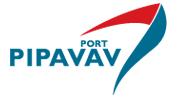GUJARAT Pipavav Port, promoted by APM Terminals, the ports division of the Danish-giant AP Moller-Maersk, has benefited from a strong growth in volume of traffic handled at its port facilities in the country for the past few years.
And that’s because of a shorter lead distance between the port and its clients in northern India. Lead distance refers to the distance in kilometers between the port and the end-user facilities. In addition, the government is focusing on expanding infrastructure facilities, including ports, which has led to increased investor interest for the sector.
Gujarat Pipavav Port plans to raise 500 crore via its offering of nearly 10.4 crore shares in the primary equity market, at the top end of the price band of 42 to 48 per share. In addition, there is an offer to sell by the existing shareholders aggregating nearly 56.2 crore. Post issue, the promoter group’s stake would reduce from 57.9% to 43.5% levels. The company plans to use up to 300 crore of the IPO proceeds for repaying loans and its secured loans amounted to 1,072.6 as of March 2010. Further, 82.5 crore are earmarked for capex to enhance the infrastructure facilities at its port, and 31.08 crore for purchasing a mobile harbour crane.
BUSINESS : Gujarat Pipavav claims to be the country’s first private sector port player and it offers both multi-cargo and multi-user operations. Gujarat Pipavav has obtained the right to develop and operate this port and allied facilities till September 2028.
The company commissioned its first jetty and commenced its cargo handling
ns in November 199 the acquisition of management control of Gujarat Pipavav by APM Terminus in March 2005, the capacities of this port have been scaled up. It can handle up to 0.6 million TEUs (twenty foot equivalent) of container cargo, as well as nearly five million tonnes of bulk cargo.
The company is principally engaged in providing port handling and marine services for container cargo, bulk cargo and LPG cargo. In addition, it also generates revenues from land-related and infrastructure activities, like warehouses and a port users’ building to accommodate offices of custom house agents and shipping lines.
Gujarat Pipavav, like other ports operating in the region, has benefited from a gradual shift in traffic towards ports in Gujarat, given a shorter lead distance between this port and its clients in northern India. As a result, during the year ended December 2009, this port had handled 3.37 million tonne of bulk cargo, a CAGR of nearly 42.5% from two years earlier. It also handled 0.32 million TEUs of container cargo at the end of CY09, a CAGR of 29.8% from two years earlier. Its larger rival Mundra Port and Special Economic Zone had handled 40.29 million tonne of cargo for the year ended March 2010, a rise of 18.3% on a CAGR basis from two year ago.
FINANCIALS: Gujarat Pipavav Port’s operating revenues grew at a compounded annual growth rate (CAGR) of 17.5% between 2006 and 2009 to reach 219.1 crore. A tight check on costs resulted into 29.7% CAGR in its operating profit at 44.1 crore during this period. However, the burden of servicing its loans resulted in a borrowing cost of 115.7 crore in CY09, a two-fold jump in three years. As a result, it had a net loss of 117.7 crore for the previous financial year. The loss has widened compared to CY08 and CY07. In addition, the company had a negative return on net worth between CY06 and CY09. In contrast, its peer Mundra Port’s (MPSEZ) operational income grew at a CAGR of 36.6% during the period ended March 2007 and March 2010 to reach 1,495.5 crore, while its net profit grew at a CAGR of 53.4% during this period to 676 crore.
CONCERNS : Gujarat Pipavav Port had reported a net loss in its three financial years ended CY09. The trend has continued even in the March 2010 quarter. This is largely due to the burden of servicing its loan, and Gujarat Pipavav is attempting to improve its financial health by utilising a part of the IPO proceeds for reducing its loans outstanding.
However, doubts still remain as to whether the company will be able to post a net profit, going forward. Senior company management highlighted that developing a port and allied infrastructure requires substantial investment over several years and they are confident of their growth prospects, considering the revival in the country’s external trade.
VALUATIONS : Gujarat Pipavav Port trades at 4.9 times its trailing book value at the top end of the price band, while rival MPSEZ trades at 9.2 times its trailing book value. However, given the rather patchy financial track record of Gujarat Pipavav Port, investors could well give this issue a miss.
 Zerodha (Trading Account)
Zerodha (Trading Account)
 Zerodha (Trading Account)
Zerodha (Trading Account)



